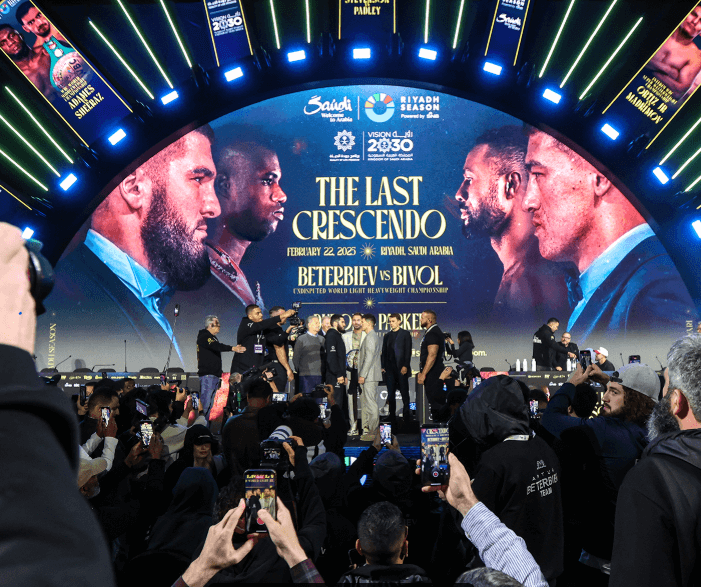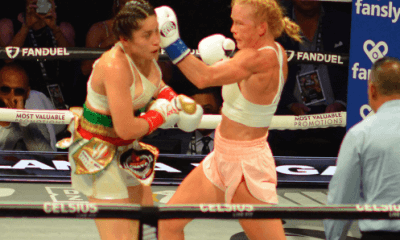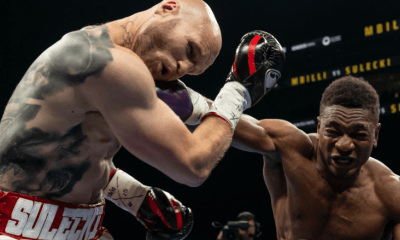Featured Articles
Two Candidates for the Greatest Fight Card in Boxing History

Two Candidates for the Greatest Fight Card in Boxing History
Saturday’s fight card in Riyadh, Saudi Arabia, topped by the rematch between Artur Beterbiev and Dmitry Bivol for undisputed light heavyweight supremacy, was being hyped as the greatest boxing card ever. That was before Daniel Dubois took ill and had to pull out of his IBF world heavyweight title defense against Joseph Parker, yielding his slot to last-minute replacement Martin Bakole.
The view from here is that the card remains in the running for the best fight card ever, top to bottom. The public didn’t view Dubois as the legitimate heavyweight champion. That distinction goes to Oleksandr Usyk.
Terms like “greatest” are, of course, subjective. Are we referring to the most attractive match-ups or the greatest array of talent, or the card that gives the most satisfaction by churning out a multiplicity of entertaining fights?
We won’t know how satisfying this card is until after the fact. We won’t know whether the talent on display was the greatest ever assembled on one night until many years have passed. Contestants such as Shakur Stevenson, Vergil Ortiz Jr, and Hamzah Sheeraz are still in their twenties (Stevenson is the oldest of the three at age 27) and it’s too soon to gauge if they will leave the sport with a great legacy.
As for which fight card in history had the deepest pool of attractive match-ups, this is a query that is amenable to an operational definition. Betting lines are a useful tool for informing us whether or not a fight warrants our attention if the likelihood of witnessing a closely-contested bout is our primary consideration.
Based on these factors, I would submit that the current leader in the race for the best card ever assembled goes to Don King’s May 7, 1994 promotion at the MGM Grand in Las Vegas.
Six future Hall of Famers – Julio Cesar Chavez, Ricardo Lopez, Azumah Nelson, Terry Norris, Julian Jackson, and Christy Martin — were on that card, an 11-fight, eight-hour marathon with five WBC world title fights, four of which were rematches.
These were the five title fights:
140 pounds: Julio Cesar Chavez (89-1-1, 77 KOs) vs. Frankie Randall (49-2-1, 39 KOs)
Odds: Chavez 3/1 (minus-300)
154 pounds: Terry Norris (37-4, 23 KOs) vs. Simon Brown (41-2, 30 KOs)
Odds: even (11/10 and take your pick)
160 pounds: Gerald McClellan (30-2, 28 KOs) vs. Julian Jackson (48-2, 45 KOs)
Odds: McClellan 7/2 (minus-350)
130 pounds: Azumah Nelson (37-2-2, 26 KOs) vs. Jesse James Leija (27-0-2, 13 KOs)
Odds: Nelson 17/10 (minus-170)
105 pounds: Ricardo Lopez (36-0, 27 KOs) vs. Kermin Guardia (21-0, 14 KOs)
Odds: none
Results
Chavez-Randall — Julio Cesar Chavez avenged his loss to Frankie Randall, but not without controversy. An accidental clash of heads in the eighth round left Chavez with a bad gash on his forehead. Ring physician Flip Homansky would have allowed the bout to continue if that had been Chavez’s preference, but El Gran Campeon wasn’t so inclined. A WBC rule specified that in the event of a significant injury accruing from an accidental head butt, the less-damaged fighter is penalized a point. The fight went to the scorecards where Chavez won a split decision that would have been a draw without the point deduction. The crowd was overwhelmingly pro-Chavez, but the big bets were mostly on Randall and the odds got nicked down on the day of the fight.
Brown-Norris — In their first meeting in December of the previous year, Simon Brown dominated Terry Norris from the opening bell before stopping him in the fourth round. It was a massive upset. Norris was in the conversation for the top pound-for-pound fighter in the sport. In the rematch, Norris opened a slight favorite, but the late money was on Brown. And, once again, the so-called “sharps” were on the wrong side. Terry Norris, the would-be avenger, won a comfortable decision.
McClellan-Jackson — A murderous puncher, Gerald McClellan bombed out Julian Jackson in 83 seconds, or four rounds quicker than in their first engagement. Jackson was also a murderous puncher and attracted money in the sports books, lowering the price on the victorious McClellan who yet remained a solid favorite.
Nelson-Leija – WBC President Jose Sulaiman mandated this rematch after the first meeting ended in a draw after an error was found in the tabulation of one of the scorecards, overturning the original verdict which had Nelson retaining his title on a split decision. Leija thought he was robbed and was the rightful winner in the do-over, outworking Nelson to win a unanimous decision. At age 35, Azumah was getting long in the tooth.
Lopez-Guardia – Before the digital age, bookmakers didn’t trifle to post lines on bouts that on paper were egregious mismatches, save perhaps a fight of great magnitude. Guardia, the Colombian challenger, overachieved by lasting the distance in a fight with no knockdowns, but “Finito” won a lopsided decision.
A Note on Odds
Betting lines serve a useful purpose for boxing historians; they quantify the magnitude of an upset. However, quoting odds is tricky because they are fluid and vary somewhat from place to place. What this means is that two journalists can quote different odds on the same event and they both can get it right – unless there is a significant disparity. The odds quoted above are the closing lines at the MGM Grand or, at the very least, a very close approximation.
Saturday in Riyadh
One reason why tomorrow’s fight card is the best ever, said the tub-thumpers, is that the card (in its original conformation) included seven world title fights. But that’s no big deal There are so many title fights nowadays that the term “world title” has been trivialized. And what wasn’t acknowledged is that three of the title fights were of the “interim” stripe.
However – and this is a big deal — a glance at the odds informs us that tomorrow’s card is chock-full of competitive match-ups (at least on paper) and from that aspect, a blend of quality and quantity, it is a doozy of a boxing card.
The greatest boxing linemaker of my generation, now deceased, once told me that any fight where the “chalk” was less than a 3/1 favorite is essentially a “pick-‘em” fight. Yes, I know that makes no sense mathematically. However, I know what he was getting at. In a baseball game, for example, it’s very rare to find a team favored by odds of more than 3/1. In boxing, where self-serving promoters are constantly feeding us King Kong vs. Mickey Mouse, odds higher than 3/1 are the norm.
As this is being written, there are six fights on Saturday’s card where one could play the favorite without laying more than 3/1. I believe this is unprecedented. Moreover, the main event and a fascinating match-up on the undercard, Vergil Ortiz Jr vs Israil Madrimov, are virtual toss-ups with the favorites, Beterbiev and Ortiz, currently available at 5/4 (minus-125). Another very intriguing fight is the heavyweight contest between late bloomers Agit Kabayel and Zhilei Zhang which finds the less-heralded Kabayel cloaked as a small favorite. And kudos to Joseph Parker for accepting Martin Bakole when he could have held out for a lesser opponent. If Bakole is in shape (a big “if”), he will be a handful.
And so, where does tomorrow’s card rank on the list of best boxing cards ever? Right up there near the top, we would argue, and, if the bouts in large part are memorably entertaining, we would push it ahead of Don King’s May 7, 1994 extravaganza.
That’s the view from here. Feel free to dissent.
Postscript: If you plan to watch the entire card ($25.99 on DAZN for U.S. buyers), it would help to stock up on some munchies. The first fight (Joshua Buatsi vs. Callum Smith) is scheduled to kick off at 8:45 a.m. for us viewers in the Pacific Time Zone / 11:45 a.m. ET. If the show adheres tight to its schedule (no guarantee), Beterbiev and Bivol are expected to enter the ring at 3:00 p.m. PT/6:00 p.m. ET.
To comment in this story in the Fight Forum CLICK HERE
Continue Reading
-

 Featured Articles3 weeks ago
Featured Articles3 weeks agoAvila Perspective, Chap. 330: Matchroom in New York plus the Latest on Canelo-Crawford
-

 Featured Articles2 weeks ago
Featured Articles2 weeks agoVito Mielnicki Jr Whitewashes Kamil Gardzielik Before the Home Folks in Newark
-

 Featured Articles4 weeks ago
Featured Articles4 weeks agoAvila Perspective, Chap 329: Pacquiao is Back, Fabio in England and More
-

 Featured Articles3 weeks ago
Featured Articles3 weeks agoOpetaia and Nakatani Crush Overmatched Foes, Capping Off a Wild Boxing Weekend
-

 Featured Articles2 weeks ago
Featured Articles2 weeks agoCatching Up with Clay Moyle Who Talks About His Massive Collection of Boxing Books
-

 Featured Articles4 weeks ago
Featured Articles4 weeks agoFabio Wardley Comes from Behind to KO Justis Huni
-

 Featured Articles1 week ago
Featured Articles1 week agoMore Medals for Hawaii’s Patricio Family at the USA Boxing Summer Festival
-

 Featured Articles4 weeks ago
Featured Articles4 weeks agoDelving into ‘Hoopla’ with Notes on Books by George Plimpton and Joyce Carol Oates





















